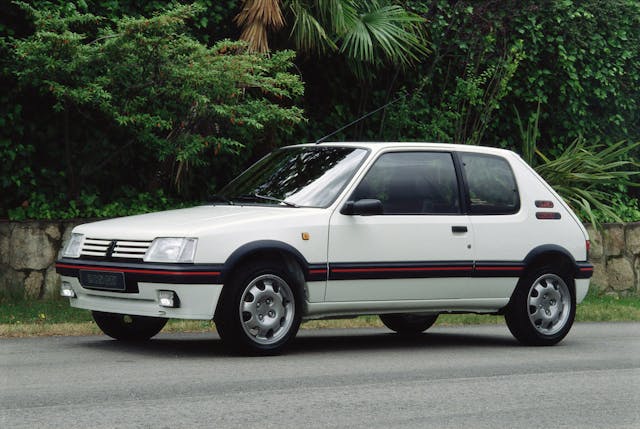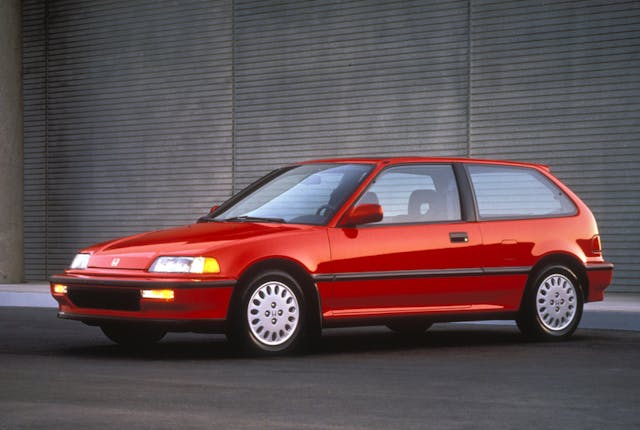Will hot hatches gain collector-car status?
I’m a Gen-Xer, but not by much. Since I’m a product of the 1980s, I got a front-row seat to one of the significant mass-extinction events in the automotive world. As with all such events, something eventually fills the niche left by the departed species: In the wake of the great dying of the British sports car, we got a new species of cheap fun, mostly from Germany and Japan.
I briefly owned a Triumph Spitfire. It was gutless, rode badly, and handled unpredictably at anything over six-tenths. A base VW Golf would run rings around it. Any modern FWD compact would. This precise realization is what gave rise to the first hot hatch, the Mk I VW Golf GTI, and my first drive in one was a revelation.
My older brother bought a new ’82 GTI, the U.S.-built version called a Rabbit. At just 90 hp, it was down on power from the German-market Golf GTI, the shifter was rubbery, and the locally sourced switchgear was cheap. But the steering was sharp, the suspension taut, and the brakes were good. Compared to my Spitfire, it felt like a GT40. I’ve been a GTI fan ever since.
I didn’t do serious seat time in a GTI again until the early ’90s when a friend bought a Mk II 16-valve car. By then, VW had shuttered the Pennsylvania plant where my brother’s Mk I had been built. The Mk IIs built in Puebla, Mexico, somehow seemed a lot more German, and I was shocked at how much better of a car it was—faster, larger, and significantly more powerful. The GTI had grown up without jumping the shark.

Americans very briefly fielded a hot hatch in the form of the Chrysler France–developed Omni/Horizon. I never drove a Dodge Omni GLH or GLHS in-period, but I did drive a 1984 GLH about ten years ago. I was shocked at how good it was compared to my recollections of my brother’s Mk I Rabbit GTI. The GLH had about 20 more horsepower than the Rabbit, because, well, Carroll Shelby. It had plenty of torque steer, but it handled pretty well, and was frankly, no less shoddily built than the Pennsylvania VW. I liked it, and I wish that Chrysler had stayed in the hot hatch game.
My mom briefly owned a Honda Accord during one of the ’80s fuel shortages. It was a competent but totally uninspiring little sedan. And that was the impression that I had of all Hondas until I saw my first bright red Civic Si around 1986. I thought the car was quite attractive in a Kamm-tail, breadvan sort of way, but I didn’t actually get around to driving an Si until 1992 or so. It was worth the wait—the fifth-generation Civic was the one that introduced VTEC into the automotive lexicon.
One of the first variable valve-timing systems, VTEC was designed to give more torque at the low-end, and more power at the upper rpm range. Although it doesn’t sound like much today, the 125 hp that the 1.6-liter naturally-aspirated four made felt much more like 150. I remained a GTI fanboy, but I got the feeling that at least from a technology standpoint, the Japanese were starting to eclipse the Germans.
I needn’t have worried. By the early aughts, the Civic Si seemed to have stagnated, with its 1.6-liter VTEC four still making the same 160 hp that it had for some time, while VW had broken the rule that a hot hatch was exclusively a four-cylinder car. They stuffed the VR6—a narrow-angle, 2.8-liter V-6—in the GTI. By 2004, in Mk IV form, the car was making 200 hp, and it remains one of my favorite hot hatches to date.

Sadly, the hot hatch segment never gained the same traction with Gen-Xers as British sports cars had with boomers. Hot hatches remained sort of thinking person’s cult cars in the U.S. with a lot of flash-in-the-pan GTI competitors like the Toyota Corolla FX16 and the Mazda 323 GTX falling quickly by the wayside. In Europe, it was a different story. The other GTi, the Peugeot 205, remains probably the prettiest hot hatch ever, and the Renault Clio Williams the most beguiling. Both cars are on my short list.
40 years on, the hot hatch segment seems itself to be on the way out. A few years ago, the criminally underrated Hyundai Elantra GT N was discontinued in favor of the unexciting Kona and Venue crossovers, and the Veloster N met a similar fate last year. The Golf GTI, Civic R, and GR Corolla are hanging on for now.

Like many of my favorite machines, these cars were made to be used, and as a consequence there aren’t a whole lot left, at least of the early models. That should drive up prices for good examples, but the segment as a whole does not appear to have consistent enthusiasm. Instead, value trends vary significantly by model and generation. Take, for instance, the two heavy hitters in this category. Mk I GTIs are up as much at 19 percent over the last year (to $20,000 for a #2-condition, Excellent example) while early ’90s Civics are trailing, with a 6.4 percent increase that brings a #2 condition car to $16,600. Hot hatches look to remain affordable and accessible for the foreseeable future, too.
At least I was around to see the whole niche develop, and regardless of what happens to the segment in the future, hot hatches remain rewarding cars to collect, drive, and own. Take it from this early convert.
***
Check out the Hagerty Media homepage so you don’t miss a single story, or better yet, bookmark it. To get our best stories delivered right to your inbox, subscribe to our newsletters.



The VW Scirocco has become pretty collectable with pristine ones over 20k. I’m lucky enough to own a pristine 1981 Scirocco S, the last year of the Giugiaro designed MK 1.
Drove many of the original Ford Fiestas in the 70s working for a dealer. Always liked those little cars.
Happy owner of a 2006 A3 VR6 Quatro S line. Best little back road car going. Super car on snow.
Someone check the acceleration times for a GLH vs a late model 3 series.